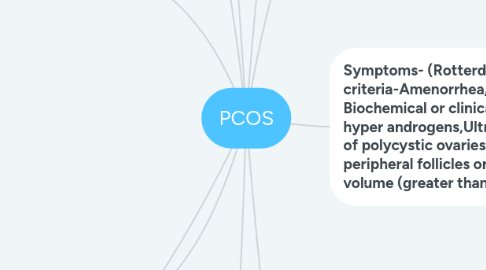
1. Cardiovascular disease
2. Risk factors
2.1. Heritable traits
2.1.1. Maternal PCOS
2.1.2. Polycystic ovarian morphology
2.1.3. Hyperandrogenemia
2.1.4. Metabolic syndrome
2.2. Inrauterine environment
2.2.1. Congential virilization
2.2.2. Disturbed intrauterine fetal nutrition
2.3. Elevated 17-hydroxyprogesterone levels (may indicate late onset adrenal hyperplasia)
2.4. Postnatal environment
2.4.1. Insulin-resistant hyperinsulinism
2.4.2. Hyperandrogenism
3. Aetiology-
3.1. Genetic (familial clustering)
3.2. Hyperandrogenism
3.3. Obesity
3.4. Insulin resistance with hyper insulinaemia
4. Differential diagnosis
4.1. Congenital adrenal hyperplasia
4.2. Cushing syndrome
4.3. Androgen secreting tumours
4.4. Thyroid dysfunction
4.5. Hyperprolactinemia
5. Investigations
5.1. Elevated prolactin levels
5.2. Elevated thyroid levels
5.3. Total free testosterone (if levels raised over 4 nanomol/L suspect an androgen secreting tumor)
5.4. Screen for type 2 diabetes
5.4.1. fasting glucose
5.5. CVD risk assessment (Qrisk2)
5.6. Sleep studies for obstructive sleep apnea
5.7. Screen for depression
5.8. Screen for gestational diabetes when pregnant
5.8.1. oral glucose tolerance test
5.9. Sex hormone-binding globulin. Normal or low in PCOS.Free androgen index (= 100 times the total testosterone value divided by the sex hormone-binding globulin value). Free androgen index is usually normal or elevated
5.10. FSH:LH levels(exclude premature ovarian insufficiency (LH and FSH both raised) and hypogonadotropic hypogonadism (LH and FSH reduced)
6. Complication and impact
6.1. Metabolic consequences
6.1.1. Gestational diabetes
6.1.2. Type II diabetes
6.1.3. Sleep apnoea
6.2. Psychological impact
6.2.1. Depression
6.2.2. anxiety
6.3. Endometrial cancer
7. Pathophysiology
7.1. Increased LH (LH:FSH Ratio 2:1).This causes theca cells to produce testosterone, low FSH means less granulose cells converting testosterone to oestrogen
7.2. Inulin resistance and hyperinsulinaemia
7.2.1. increased production of androgens from more than 1 mechanism
7.2.2. Reduced sex binding hormone causing increased free testosterone
7.3. Raised LH levels due to increased production from the anterior pituitary (in around 40% of women with PCOS).
7.4. Raised oestrogen levels in some women, which may lead to a hyper plastic endometrium.
8. Epidemology-5-15% women of reproductive age
9. Symptoms- (Rotterdam criteria-Amenorrhea/Oligomennorhea, Biochemical or clinical evidence of hyper androgens,Ultrasound evidence of polycystic ovaries-(either 12 or more peripheral follicles or increased ovarian volume (greater than 10 cm3))
9.1. Hirutism-Excess hair growth
9.1.1. idiopathic hirsutism- common , familial, diagnosis of exclusion ,Shortly after puberty , normal menstrual function and investigation
9.1.2. Drug induced-sodium valporate,glucocorticoids,danazol
9.1.3. Ovarian causes-PCOS, menopause, androgen secreting ovarian tumour
9.1.4. Adrenal causes-Androgen secreting adrenal tumour ,Cushing syndrome, Congential androgen hyperplasia
9.2. sub fertility
9.3. Obesity
9.4. Miscarriage
9.5. Acanthus nigricans-sign of insulin resistance
9.6. Alopecia
9.7. Psychological symptoms-mood changes, anxiety,depression
9.8. Sleep apnea
10. Management
10.1. Conservative
10.1.1. loos weight-improve fertility
10.1.2. smoking cessation
10.1.3. waxing ,shaving and hair removal treatments-hirsutism
10.2. Medical
10.2.1. for Oligomenorrhea
10.2.1.1. Medroxyprogestenate acid
10.2.1.2. Combines oral contraceptive
10.2.1.3. Levonostrogel releasing intrauterine system
10.2.2. for hirustim
10.2.2.1. eflornithine
10.2.2.2. Co-cyprindrol: is licensed for treating hirsutism and acne, although not specifically in PCOS
10.2.3. Diabetes
10.2.3.1. Orlistat: can help with weight loss in obese women with PCOS and may improve insulin sensitivity
10.2.3.2. Metformin: has been increasingly used off-licence for PCOS
10.2.4. Fertility
10.2.4.1. Clomifene: induces ovulation and has been proven to improve pregnancy rates
10.2.4.2. Metformin: may be used instead of or together with clomifene to improve pregnancy rates,
10.2.4.3. Laparoscopic ovarian drilling or gonadotrophins: are second-line treatments for those who are resistant to clomifene.
